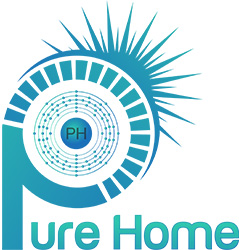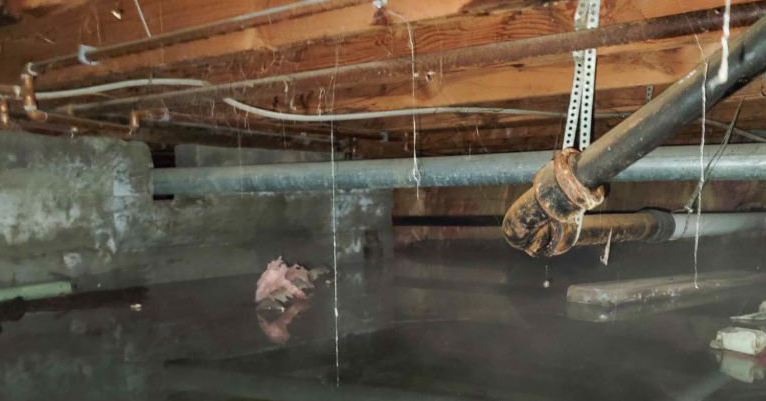Causes of Standing Water in Crawl Space
Do you have standing water in your crawl space and are unsure of the reasons behind it?
This article will explore the common causes of standing water in crawl spaces, ranging from poor drainage systems to plumbing issues and foundation issues.
Understanding the signs of standing water in your crawl space, such as musty odors and mold growth, is crucial in identifying the problem.
Stay tuned to discover effective solutions to remove standing water as well as removing mold growth that comes along with it.
Key Takeaways:
1. Standing water in crawl space can be caused by poor drainage, damaged gutters, inadequate ventilation, leaking pipes, improper grading of land, heavy rain, plumbing and foundation issues.
2. Signs of standing water include musty odor, mold growth, wood rot, rust, pest infestation, and dampness.
3. To remove standing water, identify the source, fix any issues, install a sump pump, improve drainage and ventilation, and use a dehumidifier.
What Is Standing Water in Crawl Space?
Standing water in the crawl space refers to water accumulation within the enclosed area beneath a building, typically caused by various factors such as poor drainage or plumbing issues.
Such instances of stagnant groundwater can lead to a myriad of problems for homeowners. The presence of standing water not only fosters the growth of mold and mildew but also attracts pests like termites and mosquitoes, creating a breeding ground for potential health hazards. The excess moisture can compromise the structural integrity of the foundation, leading to costly repairs if left unaddressed. Common causes of this issue include improper grading around the foundation, leaking pipes, or inadequate ventilation.
Why Does Standing Water Occur in Crawl Space?
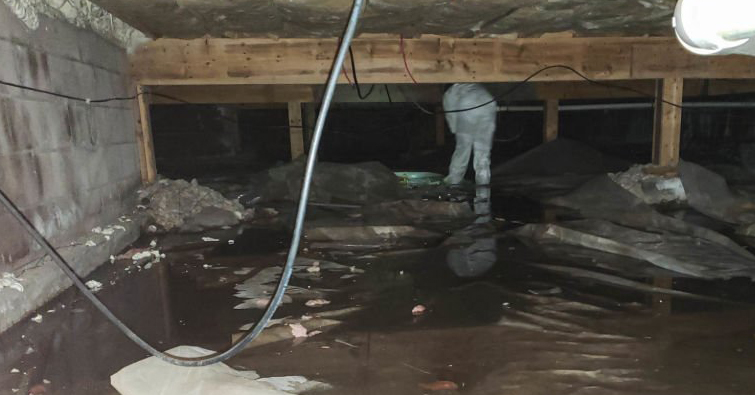
Standing water in the crawl space can occur due to a variety of reasons, including poor drainage systems, damaged gutters, inadequate ventilation, leaking pipes, heavy rain or flooding, plumbing issues, and foundation problems.
In terms of poor drainage systems, this issue often results from clogged or improperly installed gutters and downspouts. If water is not effectively directed away from the foundation, it can accumulate in the crawl space, causing significant damage over time. Inadequate ventilation can lead to excess moisture buildup, creating the perfect environment for standing water and mold growth. Leaking pipes, whether due to cracks, corrosion, or poor installation, are another common culprit behind crawl space flooding.
Poor Drainage System
A poor drainage system around the crawl space can lead to standing water accumulation, causing potential risks such as mold growth and structural damage.
Improper water diversion in the crawl space can create a breeding ground for mold, which not only poses health hazards but also deteriorates the structural integrity of the building. The moisture seeping into the foundation can weaken it over time, leading to cracks and damage. Stagnant water can attract pests like mosquitoes and termites, further exacerbating the situation. To address these issues, it is crucial to ensure efficient drainage solutions such as installing proper gutters, grading the soil away from the foundation, and utilizing French drains to redirect water flow away from the crawl space.
Damaged or Clogged Gutters
Damaged or clogged gutters can contribute to standing water in the crawl space by preventing proper water flow away from the foundation walls.
This water accumulation poses significant risks for the structural integrity of the property. When left unchecked, excess water can seep into the foundation, leading to cracks and potential water damage inside the building. The damp environment created by the standing water becomes a breeding ground for mold and mildew, which can not only affect the air quality but also pose health hazards to occupants.
Regular gutter maintenance is essential to prevent these issues. By ensuring that gutters are clear of debris and in good condition, homeowners can divert rainwater away from the foundation effectively, reducing the likelihood of water pooling in the crawl space. Investing in professional gutter cleaning and inspections can save individuals from costly repairs and health concerns associated with water damage and mold growth.
Inadequate Ventilation
Inadequate ventilation in the crawl space can lead to standing water problems, fostering conditions conducive to mold, dust mites, and structural issues.
Proper ventilation plays a crucial role in maintaining a healthy environment within a home. When moisture accumulates in the crawl space due to poor airflow, it not only creates a breeding ground for harmful allergens like mold and dust mites but also undermines the structural integrity of the building. Excess moisture can seep into the walls and floors, causing wood rot and compromising the stability of the foundation.
Leaking or Burst Pipes
Leaking or burst pipes within the crawl space can result in standing water, posing risks of mold growth, water damage, and potential structural issues.
When water accumulates in the crawl space due to leaking or burst pipes, it creates a conducive environment for mold to thrive, leading to health concerns for those within the vicinity. The prolonged exposure to moisture can weaken the structural integrity of the building, potentially causing sagging floors or rotting wood beams.
The standing water can seep into surrounding areas, escalating the risk of water damage to walls, floors, and possessions. The damp conditions also attract pests and insects, exacerbating the overall situation.
Improper Grading of the Land
Improper grading of the land around the crawl space can lead to standing water issues, potentially causing water seepage into the foundation and crawl space area.
When rainwater or irrigation does not properly flow away from the foundation due to inadequate sloping, it can accumulate around the crawl space, creating a breeding ground for moisture-related problems. This excess moisture can result in mold growth, wood rot, and structural damage within the space.
Proper slope maintenance is crucial in minimizing the risks associated with water accumulation. By ensuring that the land is appropriately graded away from the foundation, you can prevent water from seeping into the crawl space and causing potential damage.
To address grading issues, consider implementing solutions such as regrading the land to promote proper drainage, installing a French drain system to redirect water flow, or incorporating landscaping features that help with water diversion.
Heavy Rain or Flooding
Periods of heavy rain or flooding can result in standing water accumulation within the crawl space, potentially causing water damage and fostering conditions for mold growth.
When water infiltrates the crawl space, it can seep into the wooden beams and foundation of the house, leading to structural issues over time. In addition, the excess moisture can create a damp environment ideal for pests like termites and rodents, further compromising the integrity of the building.
Proper drainage systems around the perimeter of the crawl space are essential to redirect water away from the foundation. Installing a sump pump can also help in removing excess water quickly and efficiently, preventing water damage and mold growth in the crawl space.
Plumbing Issues
Plumbing issues, such as leaks or pipe damage, can contribute to standing water problems in the crawl space, necessitating prompt repairs to prevent water-related issues.
When left unchecked, these plumbing issues can lead to water accumulation in the crawl space, creating a breeding ground for mold, mildew, and potential structural damage. Regular maintenance is crucial to ensure early detection of leaks or blockages that may cause standing water. By conducting routine inspections and addressing any plumbing problems promptly, homeowners can reduce the risk of water damage and maintain a healthy living environment. Monitoring water levels, checking for dampness or odors, and repairing any visible leaks are essential steps in mitigating the risks associated with crawl space water accumulation.
Foundation Issues
Foundation issues, such as cracks or leaks, can lead to standing water in the crawl space, posing risks of structural damage and moisture infiltration.
When left unaddressed, these foundation problems can worsen over time, exacerbating the water issues and potentially affecting the overall integrity of the house. Signs of foundation damage to watch out for include uneven or sagging floors, windows and doors that stick or don’t close properly, diagonal cracks in walls, and gaps between walls and ceilings.
It’s imperative to tackle foundation problems promptly to prevent significant complications. Repairing foundation issues may involve solutions such as installing drainage systems to redirect water away from the foundation, repairing cracks with epoxy injections, or even underpinning to stabilize the foundation.
What Are the Signs of Standing Water in Crawl Space?
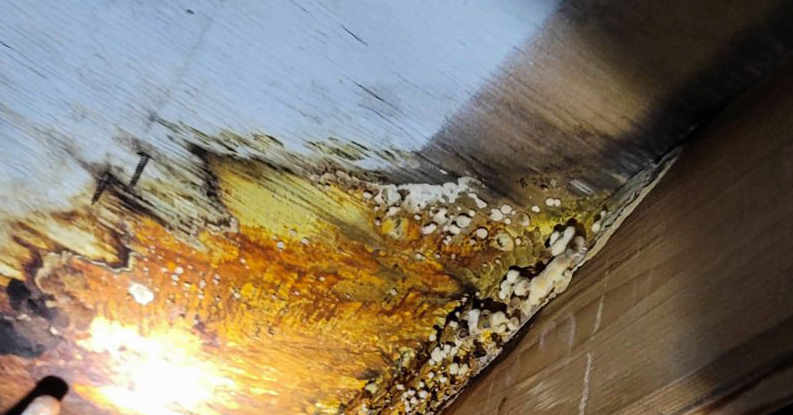
Detecting standing water in the crawl space involves observing various signs such as musty odors, mold growth, wood rot, rust, pest infestations, dampness, and moisture accumulation.
Musty odors in a crawl space can indicate the presence of mold and mildew, resulting from excess moisture. The smell may be strong and unpleasant, signaling potential health hazards and poor indoor air quality in the home.
Mold growth, often visible as patches of green or black, thrives in damp conditions and poses significant health risks, triggering allergies and respiratory issues. It can spread rapidly, damaging structural components and compromising the integrity of the crawl space.
Musty Odor
A musty odor emanating from the crawl space can indicate the presence of standing water or excessive moisture, signaling potential mold or mildew issues.
When left unaddressed, these musty odors can lead to a host of health problems due to mold exposure. Mold spores released into the air can trigger allergic reactions, respiratory issues, and exacerbate conditions such as asthma. It’s crucial to promptly investigate and address any musty smells in the crawl space to safeguard both the structural integrity of the property and the wellbeing of its occupants.
Mold and Mildew Growth
The presence of mold and mildew growth in the crawl space is a clear indicator of standing water issues, posing health risks due to mold spores and allergens.
When mold and mildew thrive in the crawl space, they release spores that can be inhaled, leading to respiratory issues and allergic reactions. Exposure to mold spores may trigger asthma attacks, worsen allergies, and cause irritation to the eyes, nose, throat, and skin.
Prolonged exposure to mold and mildew can weaken the immune system, making individuals more susceptible to infections and other health problems.
To address mold growth, it’s crucial to conduct thorough remediation efforts, including removing the source of moisture, cleaning affected areas, and improving ventilation. Prevention strategies involve controlling humidity levels, fixing leaks promptly, and ensuring proper drainage around the foundation to prevent water accumulation.
Wood Rot
Wood rot in the crawl space can be a consequence of standing water exposure, leading to structural damage and decay of wooden elements within the building.
When water accumulates in the crawl space due to poor drainage or leaks, it creates conditions ideal for fungal growth and wood decay. Over time, the integrity of the building can be compromised as the wood weakens and loses its ability to support the structure.
Not only does wood rot affect the stability of a property, but it also poses serious safety hazards, increasing the risk of collapse or structural failure. To address wood decay issues, it is crucial to identify and repair the source of water intrusion, improve ventilation, and replace damaged wood with treated materials to prevent future deterioration.
Rust or Corrosion
The presence of rust or corrosion on metal surfaces in the crawl space can indicate exposure to standing water, highlighting the risks of structural deterioration and material damage.
When metal components such as beams, pipes, or HVAC systems are affected by rust or corrosion, their integrity is compromised, leading to potential safety hazards and costly repairs.
The presence of water in the crawl space can promote mold growth, affecting indoor air quality and posing health risks to occupants.
To prevent and address corrosion issues, it is essential to maintain proper ventilation, address any leaks or water intrusion promptly, and consider using protective coatings on metal surfaces.
Pest Infestation
Pest infestations, such as termites, can be attracted to crawl spaces with standing water, posing risks of structural damage and health hazards.
When standing water accumulates in a crawl space, it creates a perfect breeding ground for pests like termites to thrive. These pests are notorious for causing extensive damage to wooden structures, compromising the integrity of buildings. The presence of termites can lead to health concerns as they carry harmful bacteria and allergens that can trigger respiratory issues.
To combat such pest infestations and mitigate the associated risks, it is crucial to address both the moisture issue in the crawl space and establish effective pest control measures. Inspecting and sealing any sources of water entry, ensuring proper ventilation, and implementing pest exclusion techniques are essential steps to prevent further infestations.
Dampness or Moisture
Excessive dampness or moisture in the crawl space can signal standing water problems, necessitating the use of dehumidifiers or vapor barriers to control humidity levels.
When left unchecked, the presence of excessive moisture in the crawl space can lead to various issues within the home. Uncontrolled humidity levels may create an ideal environment for the growth of mold and mildew, compromising indoor air quality. This can exacerbate respiratory problems and trigger allergies for the occupants.
Excessive dampness can also attract pests like termites and rodents, posing a threat to the structural integrity of the property. Not addressing moisture-related issues promptly can result in costly repairs and potential health hazards.
How to Remove Standing Water in Crawl Space?
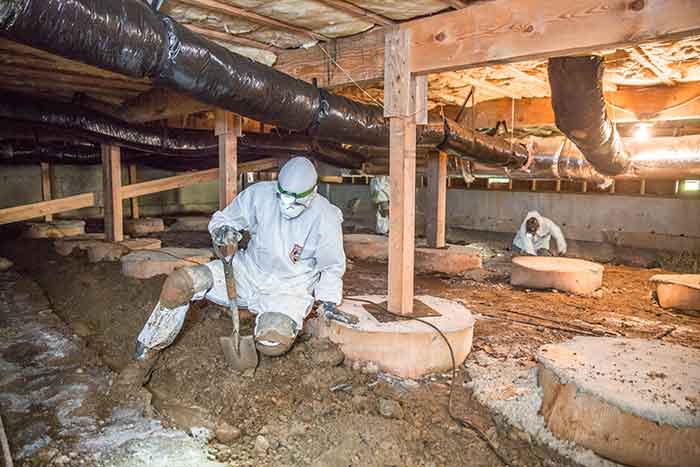
Removing standing water in the crawl space requires a systematic approach that includes identifying the water source, addressing plumbing or foundation issues, installing a sump pump, improving drainage and ventilation, and utilizing dehumidifiers.
Once the water source is identified, it is crucial to take immediate action to prevent further damage. Begin by fixing any leaks or seepage in the plumbing system or addressing any structural weaknesses in the foundation that may be allowing water to enter the crawl space. Installing a sump pump can be an effective solution for removing excess water and preventing future flooding.
Improving drainage around the crawl space perimeter and ensuring proper ventilation can help prevent water buildup by directing water away from the area and promoting drying. Using dehumidifiers can reduce moisture levels, preventing mold and mildew growth which thrive in damp environments.
Identify the Source of Water
The first step in removing standing water is to identify the source of water infiltration, whether from leaks, drainage issues, or external water ingress.
Understanding the origin of the water is crucial to effectively mitigate potential damage and prevent future occurrences. Determining if the water is coming from a burst pipe, seepage through cracks, inadequate drainage, or from the outside can dictate the appropriate remediation strategy.
To identify different water sources, one can start by conducting a visual inspection to trace back the flow of water and look for visible signs of intrusion. Utilizing moisture meters, thermal imaging, or even conducting water tests can provide further insights into the type and extent of water infiltration.
Common areas where water intrusion occurs are basements, roofs, windows, and plumbing fixtures. These areas are prone to leaks, seepage, or flooding, emphasizing the importance of regular maintenance and prompt detection to prevent extensive damage.
Fix Any Plumbing or Foundation Issues
Addressing plumbing or foundation problems is crucial in removing standing water, as leaks or structural damage can perpetuate water accumulation.
Inadequate drainage due to plumbing issues or compromised foundation can lead to water pooling around your property, causing potential flooding and damage to your home’s structure over time.
Resolving these issues promptly is essential to prevent costly repairs and maintain the integrity of your property.
In terms of repairing plumbing problems, options range from simple fixes like sealing leaks to more extensive projects such as re-piping or replacing damaged sections.
Similarly, foundation repairs may involve fixing cracks, reinforcing weakened areas, or even installing drainage systems to redirect water away from the foundation.
If these issues are neglected, they can worsen over time, leading to further water damage, mold growth, and compromising the stability of your home.
Install a Sump Pump
Installing a sump pump can effectively remove standing water from the crawl space, offering a reliable solution for continuous water drainage and management.
One of the key benefits of sump pumps is their ability to prevent water damage to the foundation of your home by keeping the crawl space dry and free of moisture. This is crucial for maintaining structural integrity and preventing mold growth.
There are various types of sump pump systems available, such as the SmartSump System, which comes equipped with advanced features like a built-in alarm system to alert you of any potential issues. This added technology enhances the overall efficiency of the pump.
In terms of installation, it is important to place the sump pump in the lowest part of the crawl space to ensure efficient water removal. Regular maintenance, including checking the pump and its components for any signs of wear or damage, is essential to keep the system functioning optimally. By following these guidelines, you can effectively manage water in your crawl space and protect your home from potential water-related issues.
Improve Drainage and Ventilation
Enhancing drainage systems and ventilation in the crawl space can help prevent standing water issues, with solutions like French drains and encapsulation systems offering long-term moisture control.
By upgrading these essential components, homeowners can safeguard their property against mold growth, structural damage, and potential health hazards associated with excess moisture. Proper drainage systems efficiently redirect water away from the crawl space, mitigating the risk of flooding and water intrusion.
Ensuring that ventilation is adequate is equally crucial, as it promotes air circulation, reducing humidity levels and preventing condensation buildup. Different encapsulation methods, such as vapor barriers and crawlspace liners, can further enhance the overall moisture management in the crawl space.
Use a Dehumidifier
Utilizing a dehumidifier in the crawl space can aid in controlling humidity levels, reducing moisture accumulation, and preventing mold growth associated with standing water issues.
By maintaining optimal humidity levels, dehumidifiers also help in preserving the structural integrity of the building by preventing wood rot and corrosion of metal components due to excessive moisture.
Controlling moisture in the crawl space can contribute to improved indoor air quality throughout the entire property, reducing the likelihood of respiratory issues and allergies caused by mold spores and other airborne contaminants.
Choosing the right size and type of dehumidifier is crucial to ensure effective operation and energy efficiency, considering factors such as the size of the crawl space, existing humidity levels, and drainage options.
Frequently Asked Questions about Causes of Standing Water in Crawl Space
What are the main causes of standing water in crawl space?
There are several potential causes of standing water in a crawl space, including poor drainage, high water table, plumbing leaks, and structural issues such as cracks or gaps in the foundation.
How does poor drainage contribute to standing water in crawl space?
Poor drainage around the perimeter of a house can lead to water pooling in the crawl space. This can be due to clogged gutters, improper grading, or lack of proper drainage systems.
Can a high water table be a cause of standing water in crawl space?
Yes, a high water table can cause water to seep into a crawl space through cracks and gaps in the foundation. This is especially common in areas with heavy rainfall or near bodies of water.
What role do plumbing leaks play in causing standing water in crawl space?
Plumbing leaks, whether from pipes or fixtures in the crawl space, can contribute to standing water. The excess moisture from these leaks can create ideal conditions for water to accumulate.
Are there any structural issues that can lead to standing water in crawl space?
Yes, cracks or gaps in the foundation can allow water to seep into the crawl space. This is especially common in older homes or those with poor construction, and should be addressed to prevent further water damage.
Do I need to be concerned about standing water in my crawl space?
Yes, standing water in a crawl space can cause a variety of issues including mold growth, wood rot, and damage to the foundation. It is important to address the underlying causes and remove the water to prevent further damage.
